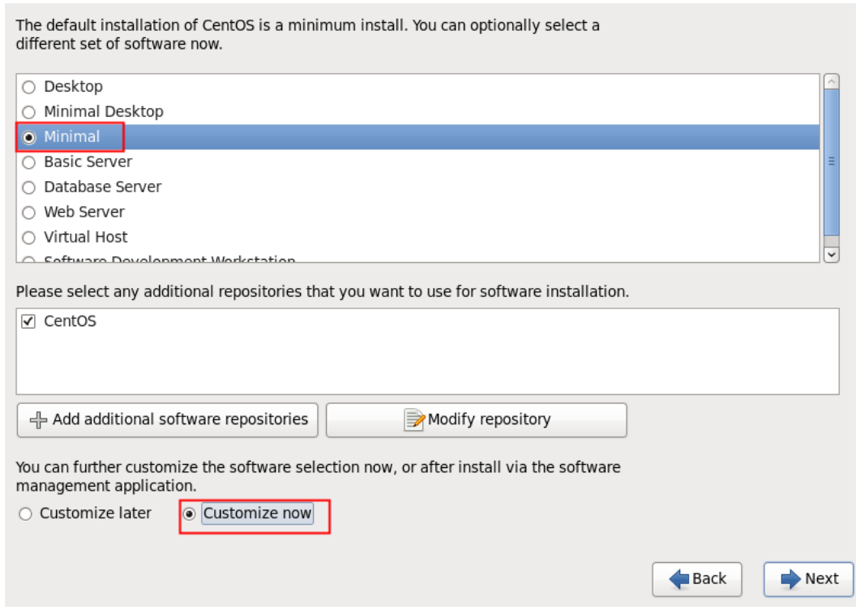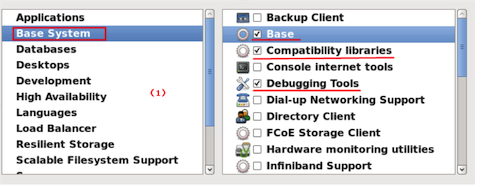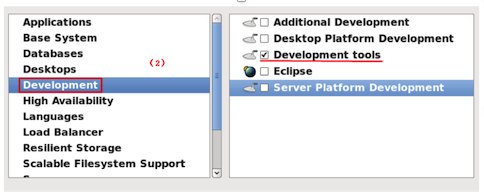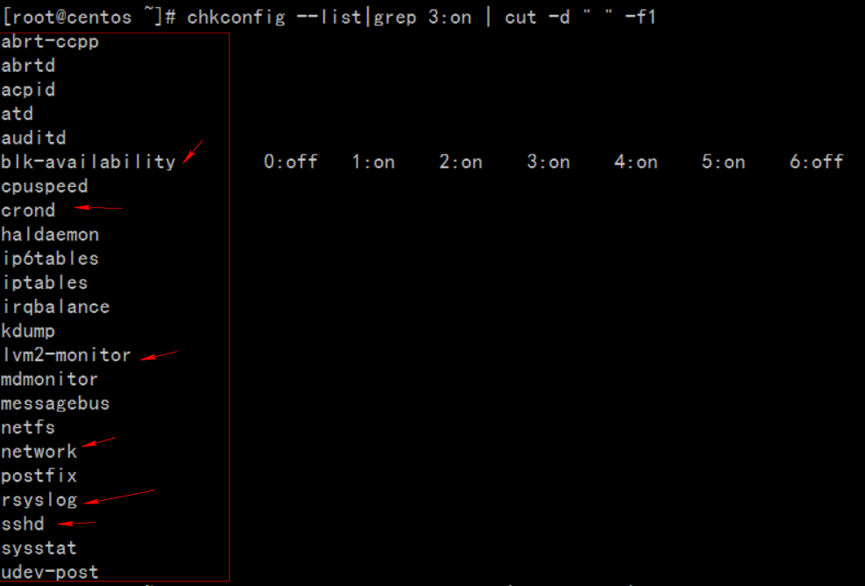導讀
Hadoop是一個能夠讓用戶輕松架構和使用的分布式計算平台,用戶可以輕松地在Hadoop上開發和運行處理海量數據的應用程序,本節講安裝並且優化centos 6.7 系統下的Supper Hadoop。 1、系統安裝類型選擇及自定義額外包組
1、系統安裝類型選擇及自定義額外包組進入如圖 1-1 所示界面。 上半部分是系統定制的不同的系統安裝類型選擇項,默認是“ Desktop”,這裡我們選擇“ Minimal”,即最小化安裝,下半部分是在上面系統安裝類型確定後, 額外想添加的軟件包組選擇項,我們選擇“ Customize now”即立即自定義。

圖 1-1 系統安裝包類型選擇及自定義額外包組。
在下圖 1-2 的自定義額外的包組界面,我們首先需要選擇左邊的大的分類,然後在勾選右邊對應的小的包組。注意:右邊小包組裡的內容默認即可,選擇結果如圖(1)、圖(2)所示。

圖 1-2 自定義安裝包組選擇界面I
 1.1 根據經驗,選擇安裝包時應該按最小化原則,即不需要的或者不確定是否需要的就不安裝,這樣可以最大程度上確保系統安全。1.2 如果安裝過程落了部分包組或者其他伙伴安裝時沒選
1.1 根據經驗,選擇安裝包時應該按最小化原則,即不需要的或者不確定是否需要的就不安裝,這樣可以最大程度上確保系統安全。1.2 如果安裝過程落了部分包組或者其他伙伴安裝時沒選安裝後可以按如下方式補上安裝時未安裝的包組:
yum groupinstall "Compatibility libraries" "Base" "Development tools"
yum groupinstall "debugging Tools" "Dial-up Networking Support"
可以通過 yum groupinfo 包組查看具體安裝的組件。
1.3 下面安裝 6.7 後登陸系統的時候查看選包的情況yum grouplist:
Installed Groups:
Base
Compatibility libraries
Debugging Tools
Development tools
E-mail server
Graphical Administration Tools
Hardware monitoring utilities
Legacy UNIX compatibility
Networking Tools
Performance Tools
Perl Support
Scientific support
Security Tools
可以看到除了我們選擇的外,系統還是默認安裝了一些必須的軟件包組。
2、網絡設置[root@centos ~]# cat /etc/sysconfig/network-scripts/ifcfg-eth0
DEVICE=eth0
HWADDR=00:0C:29:6D:58:E4
TYPE=Ethernet
UUID=5236fdbb-76ee-4f98-90cf-6bed4fb62661
ONBOOT=yes
NM_CONTROLLED=yes
BOOTPROTO=static
IPADDR=192.168.2.200
GATEWAY=192.168.2.1
NETMASK=255.255.255.0
3、Linux系統優化 Supper Hadoop
3.1 環境檢查3.1.1 操作系統
# cat /etc/redhat-release
CentOS release 6.6 (Final)
3.1.2 所有主機能夠相互ping通
3.1.3 linux內核版本
# uname -r
2.6.32-504.el6.x86_64
3.2 添加安裝集群用戶&&關閉selinux&&修改Linux啟動級別為3useradd hadoop
echo "hadoop123"|passwd --stdin hadoop
yum grouplist
sed -i 's#SELINUX=enforcing#SELINUX=disabled#g' /etc/selinux/config
setenforce 0
grep SELINUX=disabled /etc/selinux/config
grep id:3:initdefault: /etc/inittab
 3.3 優化開機自動啟動服務&&增大文件描述符(Hadoop並行讀取數據文件)&&sudo權限管理
3.3 優化開機自動啟動服務&&增大文件描述符(Hadoop並行讀取數據文件)&&sudo權限管理
chkconfig --list|grep 3:on |wc –l
chkconfig --list|grep 3:on | cut -d " " -f1
for name in `chkconfig --list|grep 3:on | cut -d " " -f1` ;do chkconfig $name off;done
chkconfig --list|grep 3:on
#如果系統基於lvm邏輯卷管理需要開啟lvm2-monitor blk-availability兩個服務
for name in crond ntpd lvm2-monitor blk-availability network rsyslog sshd;do chkconfig $name on;done
iptables -L -n
/etc/init.d/iptables stop
iptables -L -n
chkconfig --list|grep iptables
echo 'hadoop ALL=(ALL) NOPASSWD: ALL' >> /etc/sudoers
echo '* - nofile 65535' >> /etc/security/limits.conf
tail -1 /etc/security/limits.conf
 3.4 配置ntp服務器,讓所有服務器時間保持一致,如果是非內網服務器可以直接安裝啟動ntp
3.4 配置ntp服務器,讓所有服務器時間保持一致,如果是非內網服務器可以直接安裝啟動ntpyum install htpd -y
/etc/init.d/ntpd start
chkconfig ntpd on
$ ntpq –p #公網自動時間同步
如果是內網服務器,需要配置一台ntp服務器,所有服務器到ntp服務器定期同步時間,內網ntp服務器配置:
vim /etc/ntp.conf
restrict default ignore //默認不允許修改或者查詢ntp,並且不接收特殊封包
restrict 127.0.0.1 //給於本機所有權限
restrict 192.168.2.0 mask 255.255.255.0 notrap nomodify //給於局域網機的機器有同步時間的權限
server 192.168.2.124 # local clock
driftfile /var/lib/ntp/drift
fudge 127.127.1.0 stratum 10
ntpq -p 查詢網絡中的NTP服務器:
$ ntpq –p
所有機器服務器需要和ntp服務時間保持一致:
$ ntpdate 192.168.1.124 #剛剛配置好ntp服務器,大概需要5min後才能正常提供服務;報錯"no server suitable for synchronization found"
所有大數據服務器設置cron同步ntp服務器時間:
$ crontab -l
00 1 * * * root /usr/sbin/ntpdate 192.168.1.124 >> /root/ntpdate.log 2>&1
3.5 關閉防火牆/etc/init.d/iptables status
/etc/init.d/iptables stop
chkconfig iptables off
3.6 關閉Swapswapoff -a
3.7 Linux overcommit-memoryecho 0 > /proc/sys/vm/overcommit_memory
3.8 所有主機做好hosts ip映射&&repo文件# tail -6 /etc/hosts
192.168.1.124 apache-server archive.cloudera.com archive-primary.cloudera.com
192.168.1.201 server1
192.168.1.202 server2
192.168.1.203 server3
192.168.1.204 server4
所有主機同步hosts文件一致
# scp -r /etc/hosts hostname:/etc/
所有主機repo文件同步
# scp -r CentOS-httpd.repo cloudera-cdh5.repo hostname:/etc/yum.repos.d/
3.9 swappiness && transparent_hugepage#sudo echo '0' > /proc/sys/vm/swappiness
#sudo sysctl vm.swappiness=0
#sudo echo '#by whoami 2015-10-30'>> /etc/sysctl.conf
#sudo echo 'vm.swappiness=0'>> /etc/sysctl.conf
# cat /sys/kernel/mm/redhat_transparent_hugepage/defrag
[always] never
# echo never > /sys/kernel/mm/redhat_transparent_hugepage/defrag
# cat /sys/kernel/mm/redhat_transparent_hugepage/defrag
always [never]
# echo '#by whoami 2015-10-30'>> /etc/rc.local
# echo 'echo never > /sys/kernel/mm/redhat_transparent_hugepage/defrag ' >> /etc/rc.local
4、克隆虛擬機虛擬機eth0無法啟動解決,其實是因為克隆後Mac地址一致,導致沖突,而無法啟動,報錯信息如下:
Bring up interface eth0: Device eth0 does not seem to be present,delaying initialization.
刪除兩項ifcfg-eth0的配置,重啟系統即可:
rm -f /etc/udev/rules.d/70-persistent-net.rules
刪除/etc/sysconfig/network-scripts/ifcfg-eth0中,HWADDR、UUID兩項內容,重啟網卡即可解決。
/etc/init.d/network restart
本文轉載自:http://www.linuxprobe.com/centos-reduce-hadoop.html
免費提供最新Linux技術教程書籍,為開源技術愛好者努力做得更多更好:http://www.linuxprobe.com/





